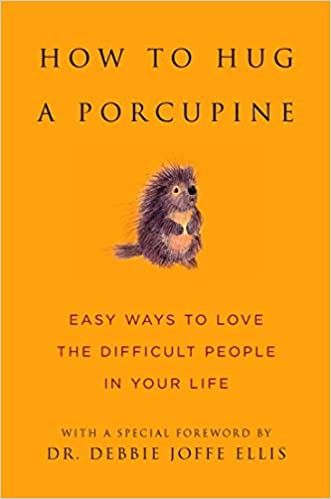
How to hug a porcupine: A Book Review.
 Write an image caption
Write an image caption
Background
How to hug a porcupine really did help me understand how to love or relate with the difficult people in our lives. I was reluctant to read it after a close associate of mine recommended it (might I add forcefully). I didn’t even plan on reading it as I already had a list of books to read but after some deliberation, I decided to read it and I’m glad I did.
The Book
 How to hug a porcupine book cover
How to hug a porcupine book cover
Title: How to Hug a Porcupine: Easy Ways to Love the Difficult people in your life.
Author: June Eding (Editor)
Forwarded by: Dr Debbie Ellis (Contributor)
Publisher: Andrew Flach
Publication Date: March 10th 2009
Publication house: Hatherleigh Press
Pages: 145 pages
Book Genre: Self-help.
Goodreads brief: “Most of us know someone who, for whatever reason, always seems to cause problems, irritate others, or incite conflict. Often, these people are a part of our daily lives. The truth is that these trouble makers haven’t necessarily asked to be this way.”
Goodreads rating: 3.41.
Have you read How to hug a porcupine: Easy ways to love the difficult people in your life? And if so what’s your take?! If not! Please do allow me to excite you on why it should be on your #2022ReadingChallenge.
Introduction
How to hug a porcupine: Easy ways to love the difficult people in your life a book by June Eding forwarded by Dr Debbie Joffe Ellis breaks down digestible easily adaptable nuggets on how to deal with the difficult people in your life yesterday, today and tomorrow.
In the book, the author uses the term porcupine as a metaphor to help us understand the nature of complicated/difficult people and why we shouldn’t necessarily fear, hate, judge or treat them badly.
“This book reminds us that we humans have the capacity to create our attitudes and emotions, as well as our actions. If we choose to, we can maintain inner peace despite difficult outer circumstances. We can prevent unnecessary suffering.”
Just like porcupines which puff themselves up to try to scare off their adversary, In a way or so difficult people would probably be indistinguishable from anyone else, except for their reaction to any kind of threat or incursion of personal space.
So what is a porcupine?!
Porcupines are rodents whose outer coats are modified with spiny hairs known as quills embedded in the skin. A single porcupine may have over 30,000 quills in his coat.
Their name derives from the Latin words “ porcus” and “ spina”, which together mean “ thorny pig”-porcupines are neither thorny nor are they related to pigs ( they are, in fact, most similar to beavers in habitat, diet and temperament).
Porcupine babies, called porcupettes, are born with soft, pliable quills which harden into defensive weapons within a matter of hours. Although some species of porcupine eat small reptiles and insects in addition to a diet of bark, roots, fruit, meadow grass, and tubers, most species of porcupines are strictly herbivores.
Generally, Porcupines are misunderstood, creatures. Porcupines cannot throw or fire their quills. Nor are their quills poisonous. In fact, when porcupines are threatened, tiny muscles at the base of each quill tighten, causing their quills to stand up and the porcupine to appear much larger than it really is.
What I liked about the book
I think the idea of using a porcupine to describe difficult people was genius as I believe they are one of the most feared and misunderstood harmless animals.
The key points are broken down into easy to digest pointers that are well explained and relatable. This way the reader is able to understand each of them, and hopefully deliberate on an action moving forward.
Often times a book will state the problem but the solution is lost in translation living the reader wondering exactly what the author was trying to put forward. This book is short, precise and engaging.
What I didn’t like about the book
Some of the advice in this book seems either too good to be considered achievable or too hard to actually do. From personal experience, I’ve been in confrontations where all I had to do is keep quiet, say sorry or let the other person feel like they got the best of me. But I did neither because sometimes it’s just hard to do for so many reasons.
In the end, learning from past experiences has helped me deal with such tricky situations.
My takeaways from the book
The person and the behaviour of that person are not the same! This might be hard to believe but it is true. Therefore, Show care and respect in all your interactions with your people, difficult or otherwise. “Too often, we focus on behaviour, instead of the motivations behind that behaviour. This is a crucial mistake, for it’s in fact the motivation behind the action that most needs to be addressed.”
Generalising people and problems is a recipe for disaster. Learn all the information there is to know before attempting to deal with the problem, might I add objectively!
Sometimes people act out not because they are bad but because of circumstance, environment, past experiences and beliefs. Take time to know what “Gets those quills up”.
Create a safe space for your people (Porcupine[s]) to feel safe and be themselves. Listen, understand, talk to them but also be realistic with them. Make them feel safe and comfortable opening up without feeling judged, attacked or misunderstood.
Personal experience.
I knew a person who I let vocalise their frustrations openly because I thought it would help me better understand the source of their pain and hurt. I figured if I let them get a lot of things off their chest, we could get along over time.
I soon realised the more I let this person do and talk as they pleased, the more disrespectfully entitled and manipulative they got. This made me sad. Our arguments became more frequent, often accompanied by manipulative guilt-tripping outbursts I often kicked under the rug until I noticed a growing pattern of violent streaks and threats which is when I knew I needed to walk away.
We all have issues! That’s a fact. I’ve learned to own mine and walk away from situations of those I can’t help fix(For me or the other person).
So, what have been your personal experiences dealing with difficult people at work, at home, in your relationships, or elsewhere. Most importantly how have you dealt with them and what did you learn from those experiences?!
Conclusions
Difficult people (Porcupines) may and often have some problems they want to get off their chests. Please, find ways to encourage them to express it in constructive ways. But if their vocalizations get personal, you have every right to walk away.
This book; How to hug a porcupine in a way tries to break down and help us understand the easy ways to love the difficult people in our life. Personally, I found some very useful tips and nuggets as well as in practice advice that almost often never works.
Appreciate the creator